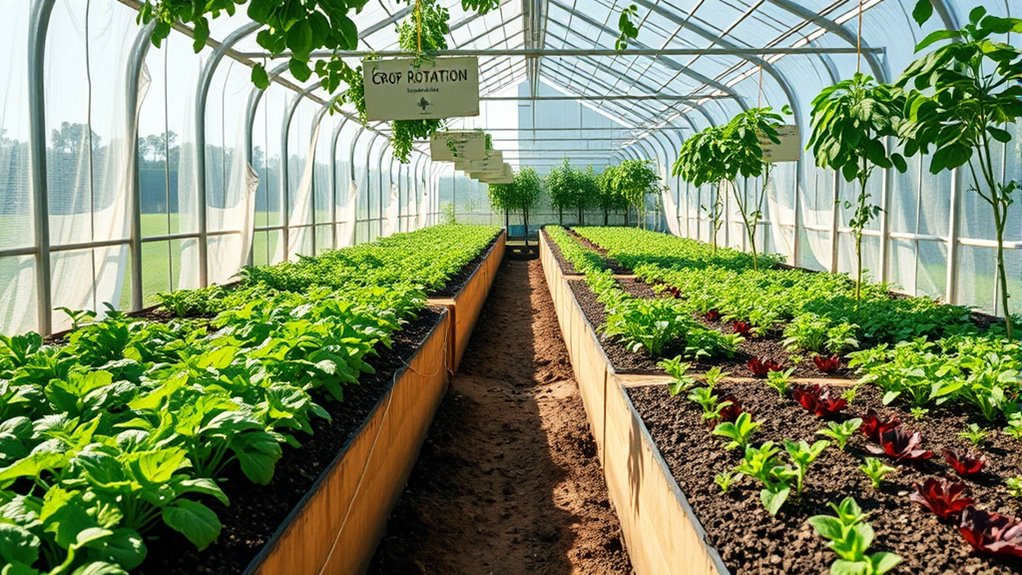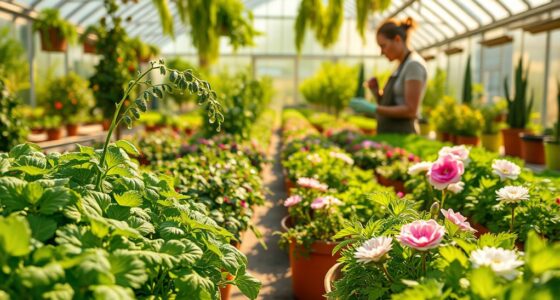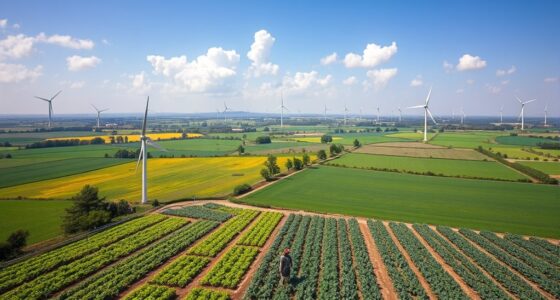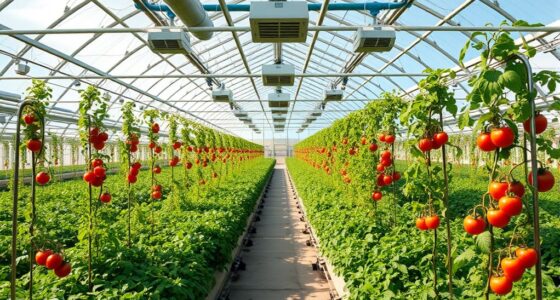To manage soil health in your greenhouse, prioritize crop rotation and composting. Rotate different plant families each season to prevent pest build-up and improve soil nutrients naturally. Incorporate compost to enrich your soil with organic matter and beneficial microbes, which boost plant health and suppress pests. These practices create a sustainable cycle that keeps your soil essential and productive over time. Keep exploring; you’ll discover how combining these methods enhances your greenhouse’s success.
Key Takeaways
- Implement crop rotation to prevent pest buildup and maintain nutrient balance in greenhouse soils.
- Incorporate compost to enrich soil with organic matter, improve structure, and boost microbial activity.
- Use crop diversity to reduce reliance on chemical fertilizers and promote a resilient soil ecosystem.
- Combine composting with crop rotation to create a sustainable, closed-loop system that enhances soil fertility.
- Healthy soil management minimizes pest and disease issues, increasing greenhouse productivity and sustainability.
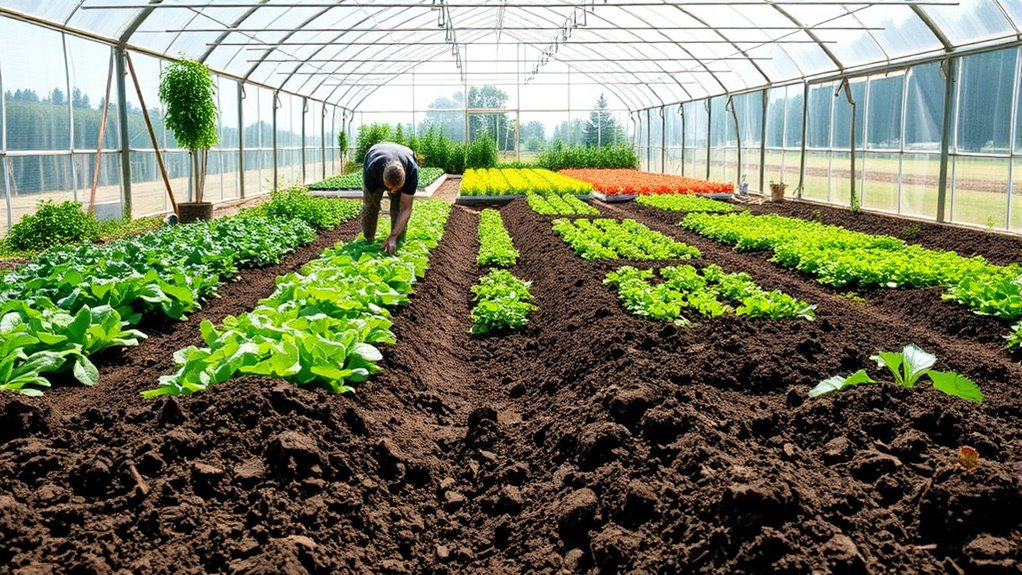
Have you ever wondered how to keep your soil healthy and productive? Managing soil health is essential for successful greenhouse gardening, and two effective strategies are crop rotation and composting. These practices not only improve soil fertility but also help you manage pests naturally, reducing the need for chemical interventions. Incorporating soil amendments thoughtfully and practicing pest management are key components to maintaining a thriving growing environment.
Crop rotation involves changing the types of plants you grow in a specific area each season. This simple yet powerful technique prevents the buildup of pests and diseases that target particular crops. For instance, planting legumes after leafy greens can break pest cycles and boost soil nitrogen levels naturally. By rotating crops, you also diversify the nutrients taken from your soil, which helps reduce the need for synthetic fertilizers. When you rotate, you allow soil amendments like compost and organic matter to work more effectively, as the soil remains balanced and less prone to nutrient depletion. This practice promotes a healthy soil ecosystem, making it more resilient to pests and diseases. Additionally, crop rotation minimizes pest management issues, decreasing your reliance on pesticides. It disrupts pest habitats and life cycles, making it harder for pests to establish a foothold. As a result, your greenhouse can stay healthier and more productive without constant chemical interventions.
Crop rotation prevents pests, boosts soil health, and reduces reliance on chemical pesticides.
Composting plays an essential role in managing soil health by recycling organic waste into nutrient-rich humus. When you compost, you create a natural soil amendment that improves soil structure, enhances water retention, and supplies essential nutrients like nitrogen, phosphorus, and potassium. These nutrients support vigorous plant growth and strengthen your plants’ natural defenses against pests. Proper composting also encourages beneficial microorganisms that suppress harmful pathogens, further aiding pest management efforts. By adding compost regularly, you can maintain a fertile, balanced soil environment that promotes healthy root development and robust plant growth. Healthy plants are less susceptible to pests and diseases, reducing the need for chemical controls. Additionally, composting reduces waste and creates a closed-loop system within your greenhouse, making your operation more sustainable. Incorporating soil amendments like compost enhances the effectiveness of crop rotation, creating a more resilient growing environment.
Incorporating these practices requires consistent effort, but the benefits are clear: healthier soil, stronger plants, and fewer pests. By using soil amendments like compost wisely and rotating your crops strategically, you’re creating an environment where pests are naturally kept in check. This integrated approach to soil health management allows you to grow more effectively while minimizing chemical dependencies. Over time, your greenhouse will become a resilient, productive space where plants thrive because the foundation—your soil—is nurtured and protected through thoughtful practices.
Frequently Asked Questions
How Often Should Crop Rotation Be Changed for Optimal Soil Health?
You should change your crop rotation frequency based on your soil’s condition and the crops you’re growing. Typically, soil renewal intervals are every 1-3 years, but it depends on factors like nutrient depletion and pest buildup. Regularly monitor your soil health to determine when to switch crops. By adjusting your crop rotation schedule accordingly, you promote nutrient balance, reduce disease risks, and maintain ideal soil health for future planting success.
What Types of Compost Are Best for Greenhouse Soil?
Imagine the secrets of thriving greenhouse soil hidden in compost! You should choose organic amendments that are fully composted and mature, as they release nutrients steadily and avoid burning plants. Well-matured compost boosts soil vitality and suppresses pests. Look for high-quality compost made from diverse organic materials, ensuring it’s aged enough to be stable. This way, your greenhouse soil becomes a powerhouse of fertility, supporting healthy, abundant crops.
Can Composting Be Done Year-Round in a Greenhouse?
Yes, you can do greenhouse composting year-round if you set up a proper system. Greenhouse composting allows you to manage organic waste continuously, providing fresh compost for your plants anytime. You’ll want to maintain ideal temperature, moisture, and aeration to keep the process active. With consistent monitoring and adjustments, year-round composting becomes feasible, helping you sustain healthy soil and improve crop yields without seasonal restrictions.
How to Prevent Pests When Using Compost in Greenhouses?
Did you know that improper composting can lead to pest issues in up to 30% of greenhouses? To prevent pests, focus on pest control by compost sterilization—heat compost to 140°F for at least 15 minutes to kill pests and pathogens. Regularly monitor your compost, avoid adding diseased plant material, and keep it well-aerated. These steps help guarantee healthy soil and minimize pest problems in your greenhouse.
What Are the Signs of Soil Degradation in Greenhouses?
You might notice signs of soil degradation in your greenhouse through soil nutrient deficiency, which causes poor plant growth, and unusual plant growth patterns like twisted or discolored leaves. You may also see compacted soil that hampers root development, or a foul smell indicating poor aeration. Regularly monitoring plant health and soil conditions helps you catch these signs early, so you can take steps to restore soil vibrancy.
Conclusion
By implementing crop rotation and composting, you naturally restore your greenhouse soil’s vitality. When you pay attention to these practices, you’ll notice healthier plants and richer harvests—almost as if the soil itself rewards your efforts. It’s no coincidence that sustainable methods lead to thriving crops; they’re simply the smart, intuitive choices you make. Ultimately, caring for your soil becomes a seamless part of your gardening routine, ensuring ongoing success without any extra fuss.
